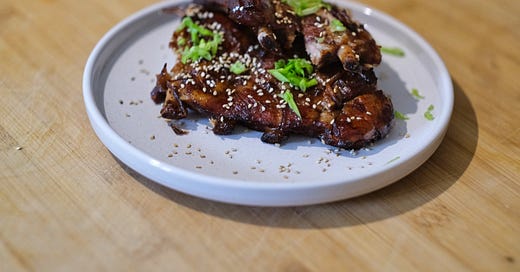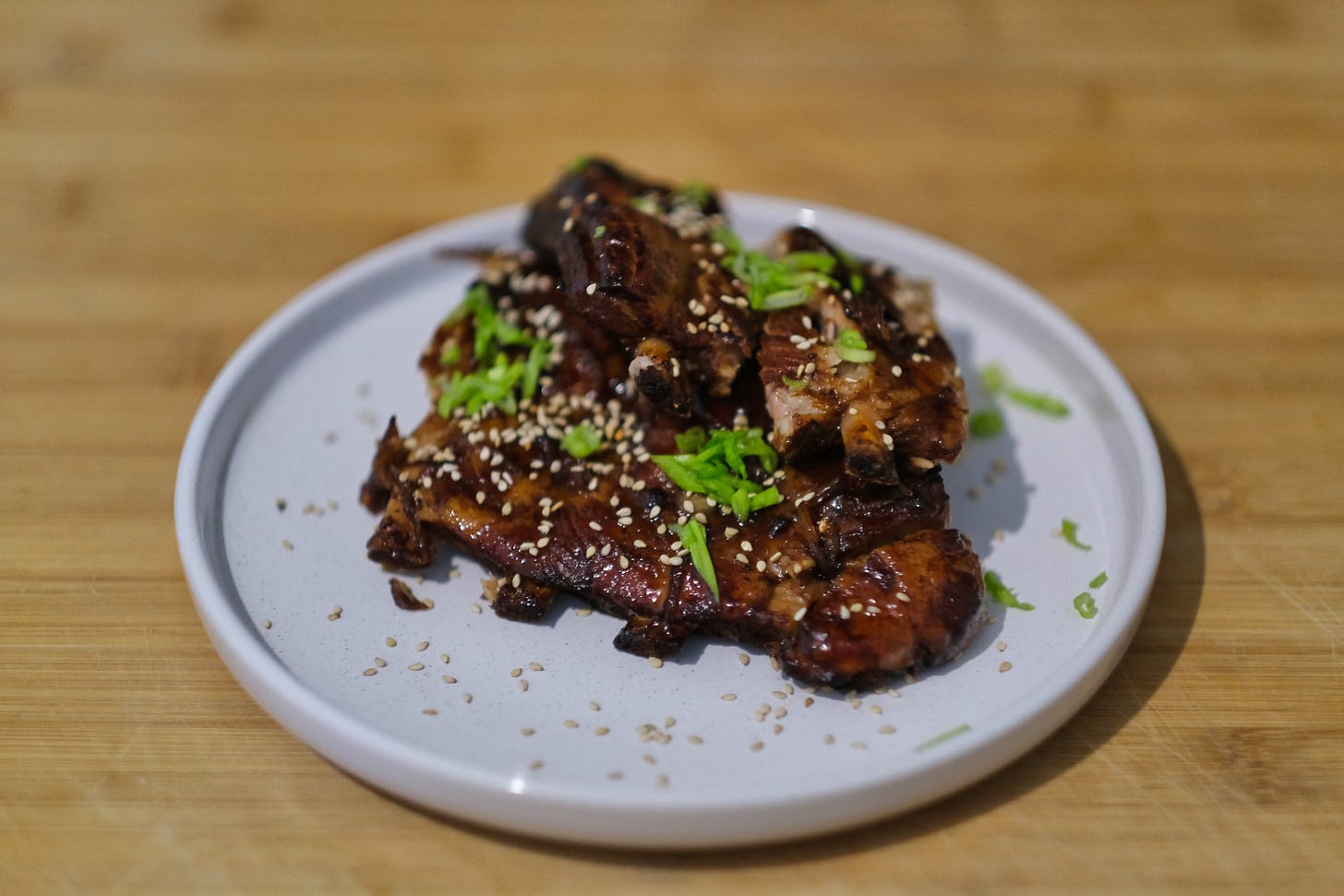Soy-glazed Ribs
An innovative approach to re-think incredibly tender pork ribs with an Asian marinade. Plus, a brief guide to approach sous-vide cooking.
Recipe
Differently from previous newsletters, this post will start straight with a recipe, leaving notes at the end. I don’t exactly know why I am doing this… But why not?
This is a recipe I developed for hyper-tender pork ribs. I use a slightly citrusy soy-based marinade that we could even argue is inspired by Ponzu sauces, if not that I like to add some star anise and shiitake to it. The presence of these last two aromatics is very subtle, though it is essential to achieve that not just another soy glaze feeling.
The procedure is quite easy, but “requires” a sous-vide cooker. I am using a quoted requirement cause I have, of course, added a non-sous-vide method, though I have not tried it out yet.
If you reached here asking yourself if you actually need a sous-vide, scroll past the recipe for some suggestions - ◡ -
Ingredients
1 whole slub of Ribs (of course)
A pinch of Sichuan Pepper
A pinch of salt
Soy Sauce 30 mL (I use 1 tbsp normal and 1 tbsp dark)
Mirin 30 mL (2 tbsp)
15 g (1 tsp) of raw brown sugar
Some juice from a sweet type of citrus (I used Satsuma Miyagawa)
A quarter of an onion, cut into slices
2 cloves of garlic, cut into slices
1 dried shiitake mushroom
A coin of ginger
A tiny piece of star anise
Preparation (sous-vide)
Clean the ribs.
Pat them dry with a paper towel.
Remove the silverskin (the membrane covering the bone side of the rack).
Dry rub the ribs with a generous pinch of ground Sichuan pepper and a pinch of salt on both sides.
Transfer the ribs to a sous-vide bag. At this step, portion the slub into 2-3 pieces to fit them in the bag size.
Add the remaining ingredients directly into the bag.
Vacuum seal the bag, making sure it is well tight and sealed.
Cook the ribs sous-vide at 74º C for ~16 hours.
When the cooking is done, transfer the bag into an ice bath for cooling down quickly, then store it.
For those without a sous-vide
Sous-vide equipment is not cheap and takes up space. You will at least need an immersion circulator, a vacuum machine with bags, and a sous-vide container.
I think cooking in the oven between 100-120 degrees Celsius for around 5-6 hours would recreate a similar result. Maybe not the same, but similar.
A good method would be to cook dry for the first 2-3 hours uncovered, just seasoned with salt and pepper, then finish the second 2-3 hours wrapped in aluminum foil and drizzled with the rest of the marinade.
I still have to try this oven method, but I am pretty confident. If you do try, let me know in the comments!
Reheating, Glazing, and Serving
Preheat the oven with the grill on at 220 ºC.
Put the whole content of the bag in a tray.
Cook in the oven under the grill at 220 ºC for 20-30 minutes until a slightly brown crust forms.
Optionally, for glazing:
Reserve some of the juice aside.
Add a tablespoon of soy sauce and a teaspoon of raw brown sugar. Mix well.
For a stickier glaze, optionally add a teaspoon of cornstarch. Mix well.
Brush the ribs with the juice and put them back in the oven for a couple of minutes. For a thicker glaze, repeat multiple times.
Serve with fresh green onion and white sesame seeds!
Storage
Cooked ribs can be stored in the original sealed bag.
The bag can last up to 5 days in the fridge or 3 months in the freezer if frozen fresh after cooking.
Did someone say sandwich?
Ribs burgers are no news, though they are still not glorified enough. While pulled pork had (and maybe still has) its time, I think ribs burgers take it to the next level, both in texture and flavor. My oldies always kept saying that the meat around the bones is the best one. Well, now I guess I believe them.
However, nearly every ribs burger I have seen out there is still sticking to a classic palette of BBQ marinades. Time to open up to more Asian-inspired flavors?
I have some ideas, including daikon coleslaw and caramelized spring onions. I might write another recipe for this in the future!
To sous or not to sous…
Sous vide is a cooking technique that involves vacuum sealing food in bags and immersing them in a water bath at a precision-controlled temperature. It was invented by a French chef in 1974 and has become popular among professionals and home cooks alike.
While having many benefits, sous-vide also has disadvantages and requires some initial investment that does not make sense for everybody.
Here are some of the advantages of sous vide cooking:
Virtually, it guarantees perfect results every time. Food can be cooked to the exact “doneness” you prefer, without worrying about overcooking or undercooking it. Plus, the process is always repeatable with the same precision, as you can perfectly control both the time and temperature variables.
In some cases, it enhances the flavors and textures. Cooking in a closed environment (aka in the sealed sous vide bag) preserves the natural juices and aromas of food. This does not apply to everything, but for braised meat in particular consider that no juice at all is ever leaving the bag!
Control and Precision. As someone who used to always cook by intuition, it is incredible what you can achieve at controlled temperatures and time. I could argue one can thoroughly adjust pork ribs tenderness. Want them to fall apart? Cook for 17+ hours. Like to “bite” them? Cook for 14 hours. Plus, sous-vide is not restricted to meat and vegetables. You can even make sauces, desserts, custards, and more with it. Anytime you need a controlled temp, for instance.
It frees up time and attention. You don’t have to monitor or worry about timing. Sometimes, I even leave the bags cooking overnight. Plus, food can be prepared in advance and easily left in the bags for an effectively safe storage.
Some of the disadvantages of sous vide cooking are:
It requires special equipment. You will need a sous vide machine, which can be expensive and take up space. You also need accessories such as a vacuum-sealer and vacuum-sealable bags.
It lacks the browning and crisping effect. Now, this is not completely true. Out of the box (or should I say, out of the bags: not a funny joke) sous-vide-cooked food will not look great. Since it is a wet cooking method, it will also lack external texture. On the other hand, it is pretty straightforward to apply external searing before or after sous-vide. If you use browning for flavor, you can brown the food before sealing it. I do this for ossobuco. If you need searing for a crispy texture instead, you can apply it after cooking, for example searing an already cooked sous-vide steak.
It can pose some risks if not approached properly. Always refer to international food safety tables for cooking temperatures and times for different food. If you need to cook an entire chicken sous-vide, don’t come up with your own temperature-time set and call it a goal. Sous-vide cooking requires initial research to be safe against bacteria growth and killing pathogens. Once learned, though, this is easy to bring forward.
So, when should you consider sous-vide?
Sous vide cooking can be a great technique for achieving precise and consistent results, though it is not suitable for every situation. Here are some general guidelines on when to sous vide and when not in my opinion:
Yes:
When you want to cook food to specific criteria, such as tender chicken breast, perfect ribs, pink pork steak, or creamy eggs.
When you are dedicated to cooking and have initial time, money, and space to invest in the equipment and how to use it.
When you want to free up your time and attention, such as preparing food in advance, cooking large batches, or avoiding constant monitoring.
No:
When time is a big issue and you need to cook food quickly.
When you are concerned about food safety. Again, this is easy to overcome, but if you are concerned or can’t give it enough attention, it’s a no.
If you mostly enjoy the intuitive, improvising, fun aspects of cooking. Sous-vide “isn’t fun”. It is technical. Developing recipes and eating is still fun, but the cooking experience itself is not there, plus it has to follow specific rules and steps.
Sous vide cooking is a pro technique that can elevate food and culinary skills. But it is not for everyone. It has its own challenges and limitations. Whether you choose to go for it or not, the most important thing is to enjoy your food and have fun in the kitchen.
Bon appétit!
— The Ramen Bowl - ◡ -
If you’re not yet a subscriber and like The Ramen Bowl, leave your email to start receiving all the new posts directly in your inbox! 👇






That recipe sounds amazing, it with out the right style of cooker I guess my husband, who absolutely loves ribs, will have to suffice with an attempt to cook them with the ingredients mentioned in the oven. 👩🍳🤗
This sounds fabulous. I have a sous vide cooker, but am wary of using it for, as you mentioned, food safety concerns. When my husband was alive, he used it for infusing alcohol. Worked amazingly well, and produced intense flavors. I’m going to try your recipe in the oven, or maybe in an instant pot. Thanks for sharing it.